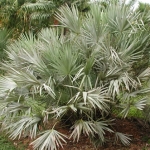| Drug Interactions: |
| Taking saw palmetto with these drugs may reduce or prevent drug absorption: |
| Ferric Gluconate, (Ferrlecit) |
Ferrous Fumarate, (Femiron, Feostat) |
Ferrous Gluconate, (Fergon, Novo-Ferrogluc) |
Ferrous Sulfate, (Feratab, Fer-Iron) |
| Ferrous Sulfate and Ascorbic Acid, (Fero-Grad 500, Vitelle Irospan) |
Iron-Dextran Complex, (Dexferrum, INFeD) |
Polysaccharide-Iron Complex, (Hytinic, Niferex) |
| Taking saw palmetto with these drugs may increase the risk of bleeding and bruising: |
| Abciximab, (ReoPro) |
Acemetacin, (Acemetacin Heumann, Acemetacin Sandoz) |
Antithrombin III, (Thrombate III) |
Argatroban, (Argatroban) |
Aspirin, (Bufferin, Ecotrin) |
Aspirin and Dipyridamole, (Aggrenox) |
| Bivalirudin, (Angiomax) |
Celecoxib, (Celebrex) |
Choline Magnesium Trisalicylate, (Trilisate) |
Choline Salicylate, (Teejel) |
Clopidogrel, (Plavix) |
Dalteparin, (Fragmin) |
| Danaparoid, (Orgaran) |
Diclofenac, (Cataflam, Voltaren) |
Diflunisal, (Apo-Diflunisal, Dolobid) |
Dipyridamole, (Novo-Dipiradol, Persantine) |
Dipyrone, (Analgina, Dinador) |
Enoxaparin, (Lovenox) |
| Eptifibatide, (Integrillin) |
Etodolac, (Lodine, Utradol) |
Etoricoxib, (Arcoxia) |
Fenoprofen, (Nalfon) |
Flurbiprofen, (Ansaid, Ocufen) |
Fondaparinux, (Arixtra) |
| Heparin, (Hepalean, Hep-Lock) |
Ibuprofen, (Advil, Motrin) |
Indobufen, (Ibustrin) |
Indomethacin, (Indocin, Novo-Methacin) |
Ketoprofen, (Orudis, Rhodis) |
Ketorolac, (Acular, Toradol) |
| Lepirudin, (Refludan) |
Magnesium Salicylate, (Doan's, Mobidin) |
Meclofenamate, (Meclomen) |
Mefenamic Acid, (Ponstel, Ponstan) |
Meloxicam, (MOBIC, Mobicox) |
Nabumetone, (Apo-Nabumetone, Relafen) |
| Naproxen, (Aleve, Naprosyn) |
Niflumic Acid, (Niflam, Nifluril) |
Nimesulide, (Areuma, Aulin) |
Oxaprozin, (Apo-Oxaprozin, Daypro) |
Piroxicam, (Feldene, Nu-Pirox) |
Rofecoxib, (Vioxx) |
| Salsalate, (Amgesic, Salflex) |
Sulindac, (Clinoril, Nu-Sundac) |
Tenoxicam, (Dolmen, Mobiflex) |
Tiaprofenic Acid, (Dom Tiaprofenic, Surgam) |
Ticlopidine, (Alti-Ticlopidine, Ticlid) |
Tinzaparin, (Innohep) |
| Tirofiban, (Aggrastat) |
Tolmetin, (Tolectin) |
Valdecoxib, (Bextra) |
Warfarin, (Coumadin, Jantoven) |
| Taking saw palmetto with these drugs may increase the action of the drug: |
| Cavedilol, (Coreg) |
Labetalol, (Normodyne, Trandate) |
Prazosin, (Minipress, Nu-Prazo) |
|

